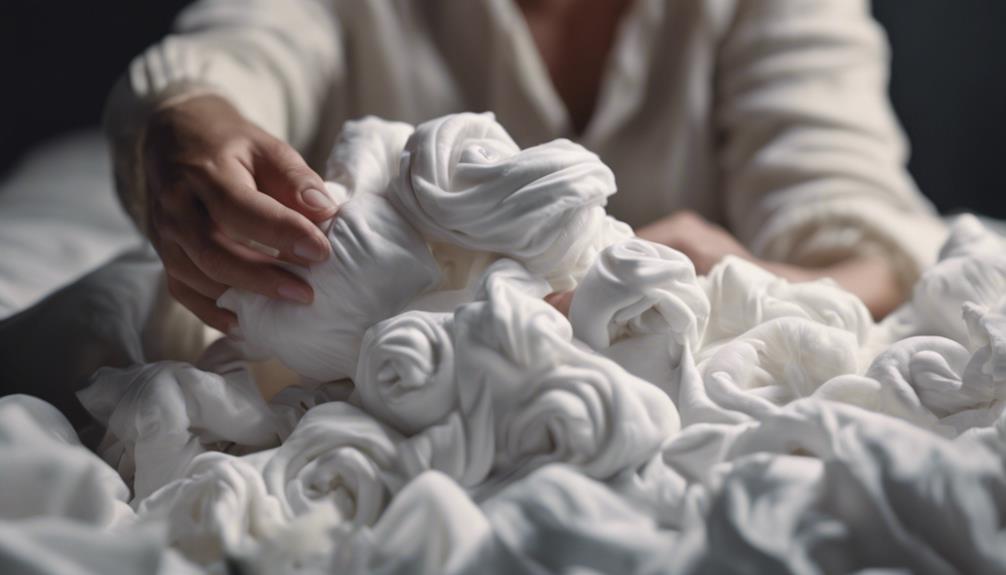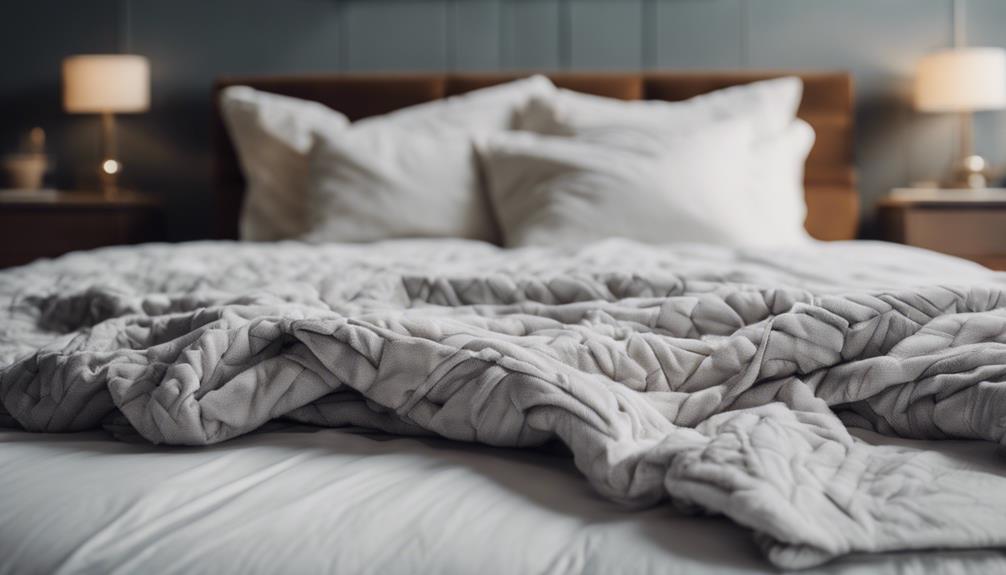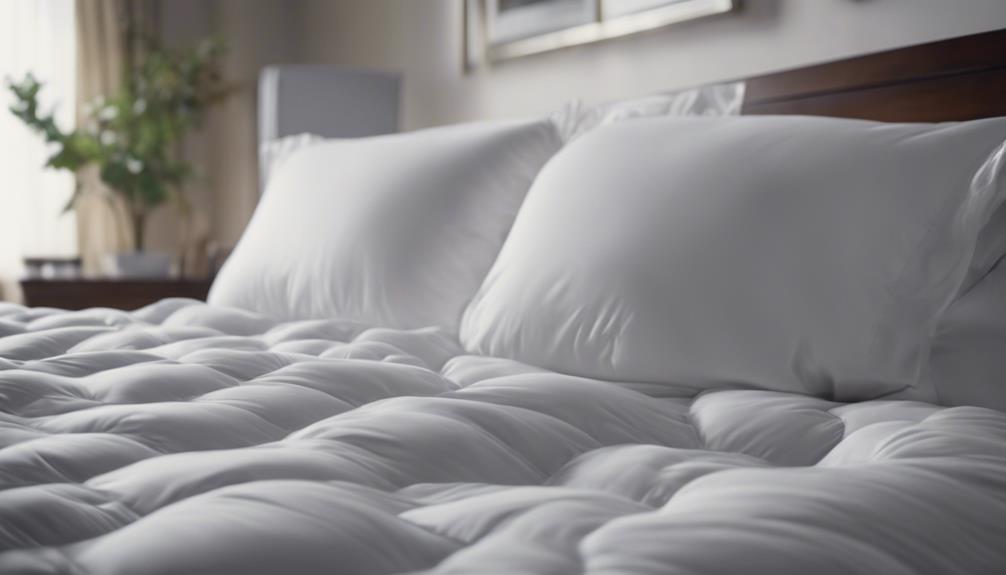New down comforters might have a scent due to chemicals used in feather disinfection and the natural smell of the material. Factors like packaging and where it was made also play a role in the odor. The quality of the down and where it was produced can impact the scent as well. Chemicals from manufacturing and how it is stored can make the smell stronger. Proper care such as washing and air-drying can help prevent strong odors. High-quality down and specific cleaning methods can help reduce the scent. Understanding the materials and cleaning techniques can be beneficial in minimizing the odor. More information on how to eliminate the smell can offer additional tips for maintaining a fresh comforter.
Key Takeaways
- Chemicals in manufacturing processes and natural odors from down feathers contribute to the initial smell.
- Environmental factors like packaging and storage conditions can intensify the odor.
- Quality of down material and treatments impact the intensity of the smell.
- Proper care instructions, including washing and airing out, are crucial to prevent lingering odors.
- Cleaning techniques like using vinegar or mild detergent can eliminate the smell effectively.
Reasons for the Smell
When we encounter a new down comforter, the smell often stems from the chemicals used in disinfecting the down feathers. These chemicals, necessary for maintaining cleanliness and ensuring product safety, can give off a distinct odor that lingers initially.
Apart from chemicals, natural odors from the down feathers themselves contribute to the overall scent of a fresh down comforter. Environmental factors, like storage in plastic packaging or conditions during shipping, can also play a role in how the comforter smells when first unpacked.
The quality of the down material and the specific manufacturing processes employed further influence the odor of the comforter. Additionally, the location of production and varying manufacturing standards can impact the overall smell of the down comforter.
Understanding these different elements that contribute to the scent of a new down comforter can help users better appreciate the complexities involved in its production and initial presentation.
Chemicals and Natural Odors

The interplay between chemicals and natural odors greatly influences the initial scent of a new down comforter. When it comes to the smell of your fresh comforter, here are some key points worth noting:
- Chemicals in Manufacturing Processes: Some new down comforters may emit odors due to the chemicals used in their manufacturing processes.
- Natural Odors from Down Feathers: The natural odors from the down feathers themselves can also contribute to the initial smell of a new comforter.
- Plastic Packaging Impact: Prolonged storage in plastic packaging can retain odors and intensify the smell of the comforter.
- Quality and Treatments: The quality of the down material and the manufacturing processes it undergoes can greatly influence the intensity of the odor emitted by the comforter.
Choosing a down comforter with fewer chemical treatments can help reduce the initial odors you may encounter when unwrapping your new bedding.
Environmental Factors During Storage
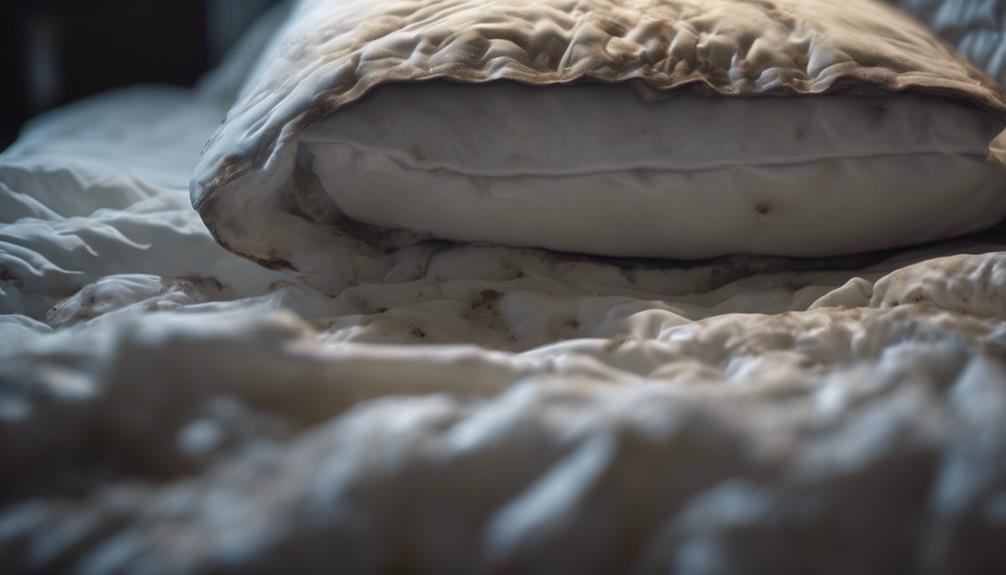
During storage, our new down comforters can be influenced by environmental factors like humidity and temperature, which may impact the lingering smell. If not stored properly, the lingering smell in new comforters can be intensified. Prolonged storage in plastic packaging can trap odors, while lack of ventilation can make the odor worse. The chemicals used in packaging materials may also interact with the down, creating a distinct smell.
To guarantee or minimize odors, it's crucial to wash down comforters with mild detergent, make sure they're thoroughly air-dried to remove excess water, and then store them in breathable containers or fabric bags. Failure to follow proper care instructions can lead to a moldy smell developing in the comforter. By understanding how environmental factors during storage can affect the smell of new down comforters, we can take the necessary steps to keep them fresh and odor-free.
Quality of Down Material
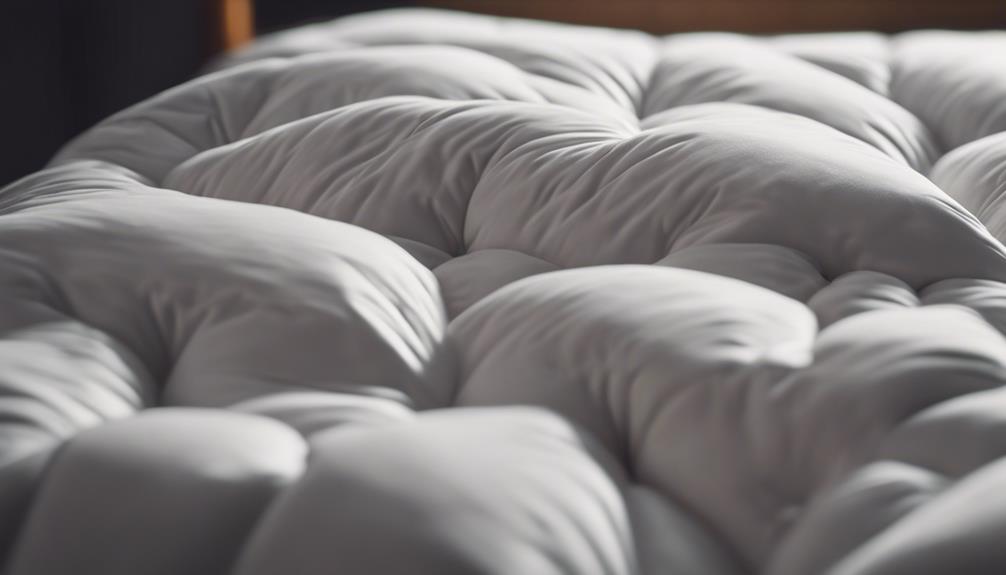
Taking into account the impact of down material quality on the odor of a comforter, it becomes evident that higher quality down generally possesses fewer natural odors.
- Premium down comforters are often treated to reduce natural odors and enhance freshness.
- Lower quality down may have a stronger natural odor that requires more thorough airing out.
- Quality down material is often sourced from reputable suppliers known for their responsible and ethical practices.
- Understanding the quality of down material can help in selecting a new comforter with minimal initial smell.
When choosing a comforter, the quality of the down material plays a significant role in the overall odor. Higher quality down tends to have fewer natural odors, while lower quality down may require more airing out to reduce its initial smell. Premium comforters are often treated to enhance freshness, ensuring a pleasant experience. It's essential to take into account the sourcing of the down material, as reputable suppliers with ethical practices contribute to a better quality product. By understanding these factors, one can make an informed choice to enjoy a comfortable and odor-free sleeping environment.
Fabric Covering and Cleaning Methods
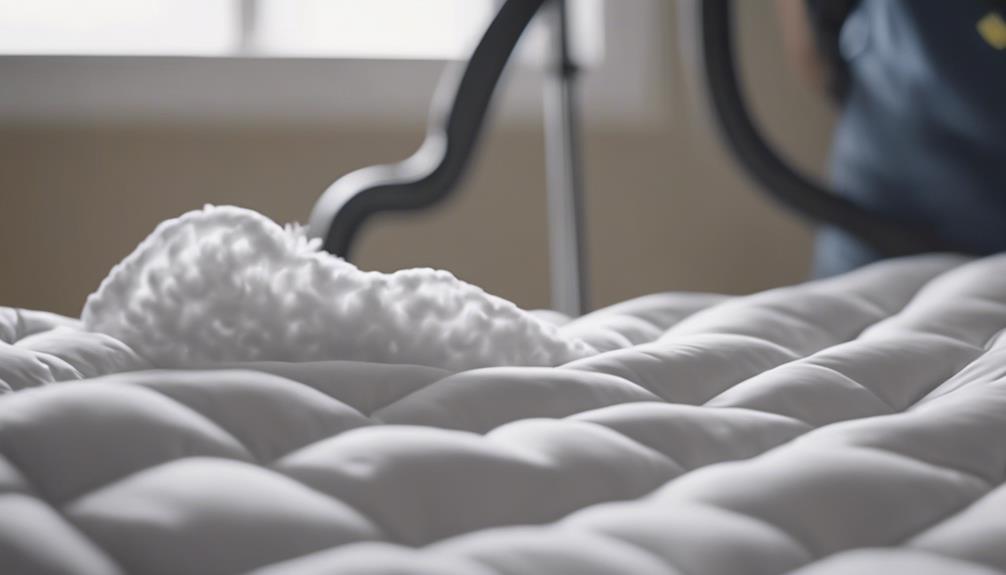
The fabric covering of your down comforter plays a significant role in the odors it emits. Cleaning techniques like washing with vinegar or mild detergent can help eliminate unwanted smells from the covering.
Opting for natural materials like cotton or bamboo may reduce the presence of chemical odors in your comforter.
Covering Material Options
Choosing the right fabric covering for your down comforter can play a significant role in minimizing odor retention and maintaining freshness. Here are some key points to take into account when selecting the covering material:
- Fabric covering options: Contemplate cotton, silk, or organic materials like bamboo for reduced odor retention.
- Natural fibers: Cotton can absorb moisture and odors, while silk offers luxury and odor resistance.
- Cleaning methods: Spot clean with mild detergent or opt for dry cleaning to preserve the fabric covering.
- Breathability and ease of cleaning: Select a fabric that's breathable and easy to clean for a fresher-down comforter experience.
Cleaning Techniques
To maintain the freshness of your down comforter, it is important to utilize effective cleaning techniques for the fabric covering and cleaning methods. When dealing with moldy smells, washing with bleach and airing out in direct sunlight can help. Using white vinegar in warm water is also effective for cleaning and removing odors from the fabric covering. Consider incorporating Mule Team Borax with detergent to refresh the fabric. Alcohol-based products like vodka can help eliminate moldy smells. Professional dry cleaning services may offer specialized treatments for a thorough clean. Here is a table summarizing some cleaning techniques:
| Cleaning Technique | Description | Effectiveness |
|---|---|---|
| White vinegar in warm water | Cleans and removes odors | High |
| Washing with bleach | Eliminates moldy smells | Effective |
| Mule Team Borax with detergent | Cleans and refreshes fabric | Recommended |
Remedies for Removing the Smell

One effective way to combat the smell of a new down comforter is through proper airing and sun exposure. Here are some remedies for removing the smell:
- Using Baking Soda or Vinegar: Adding baking soda or vinegar during washing can help eliminate odors from the comforter.
- Opting for Professional Cleaning: Dry cleaning or professional cleaning services are effective in tackling the odor issue in a new down comforter.
- Scented Sachets or Dryer Sheets: Using scented sachets or dryer sheets can mask the initial smell of the comforter with a pleasant fragrance.
- Consider Alternative Fillings: If the smell persists, consider replacing the down filling with hypoallergenic options like wool or cotton.
These remedies can help freshen up your new down comforter and make it more enjoyable to use.
Frequently Asked Questions
How to Get Smell Out of New Down Comforter?
To guarantee the smell out of a new down comforter, try airing it outside in the sun. Using a fragrance spray as a temporary fix can also help. Additionally, washing it with white vinegar and mild detergent, and adding tennis shoes in the wash can be effective. Assure thorough drying by air drying outside to remove any remaining odors.
These methods can effectively eliminate unwanted smells and keep your comforter fresh and cozy.
Why Do Down Comforters Smell Bad?
Down comforters may smell bad due to various factors. These include chemicals used in manufacturing, natural odors from feathers, and environmental factors during storage or shipping. The quality of the down material, manufacturing processes, and location can also contribute to the unpleasant smell.
Inadequate airing out, absorption of odors from surroundings, and the type of fabric covering the down impact the persistence of the smell. Geographical factors like manufacturing standards, import sources, and regulations on chemical usage can affect the smell.
Why Does My Goose Down Duvet Smell?
We notice that goose down duvets can emit a smell due to natural odors from the feathers. Environmental factors during storage or shipping can contribute to this smell. The quality of the down material used in the duvet can also impact the intensity of the odor.
Manufacturing processes and location can play a role in the initial smell of goose down duvets. Additionally, chemicals used for disinfecting the down feathers may add to the odor.
How to Stop Feather Duvet From Smelling?
To prevent a feather duvet from smelling, there are several steps you can take. First, air it outside regularly to freshen it up. Additionally, using fabric fresheners can help keep it smelling pleasant. Follow the care instructions for washing to ensure it stays clean and odor-free. Avoid storing it in plastic for extended periods, as this can trap odors. Consider opting for organic or hypoallergenic options for a more natural and fresh bedding experience. By following these tips, you can maintain a fresh-smelling duvet.
How Can I Get Rid of the Smell from My New Down Comforter?
When dealing with strong odors on a new down comforter, consider using these down comforters washing tips to remove the smell. Start by adding a cup of white vinegar to the wash cycle, then use a gentle detergent and dry thoroughly. Follow these steps to enjoy a fresh, odor-free comforter.
Conclusion
To sum up, that funky smell coming from your new down comforter is like a stubborn guest who's overstayed their welcome.
By understanding the reasons behind the odor, from chemicals to storage conditions, you can take steps to freshen up your bedding.
With a bit of patience and some simple remedies, you'll soon bid farewell to that unwelcome scent and enjoy the cozy comfort of your down comforter.
